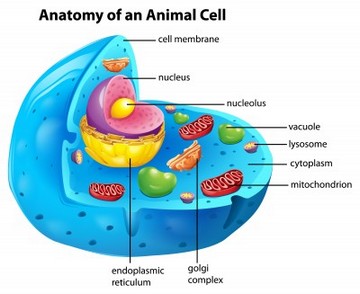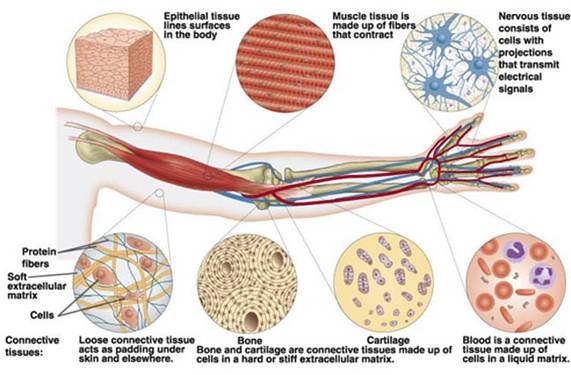CBSE Class 11 Biology Chapter 7 Revision Notes Part 1
Chapter 7: Structural Organisation in Animals Revision Notes Part 1
The human body is composed of billions of cells to perform various functions. Have you ever wondered how these cells in the body manage to work together? Cells, tissues, organs and organ systems split up the work in a way that exhibits division of labour and contribute to the survival of the body as a whole.
What is structural organisation in animals?
All organisms of the animal kingdom are made up of similar structures. They start from the basic unit of life, the cell, and further develop tissues, the tissues go on to form organs, and then an entire organ system is formed. Every organism is multicellular, but despite being multicellular, they do not depict the same pattern of organization in the cells.
What are the types and levels of organization in animals?
The various levels of organization in animals are classified into:
1. Cellular level of organization: Animals exhibit this type of organization whereby the cells are arranged to form loose aggregates of themselves. A typical example of this type of organization is observed in the sponges.
2. Tissue level of organization: Here, the cells of the respective animals tend to show divisions in their cell activities. Cells that perform the same functions will be arranged as particular types of tissues. This type of organization is observed in coelenterates.
3. Organ level of organization: Similar tissues that exhibit the same functions in a certain group of animals are grouped, and they form an organ. Every organ has a specific function. This type of organization is observed in platyhelminthes.
4. Organ system level of organization: Animals, in which the organs are associated with forming functional systems where every system is concerned with certain physiological functions, are observed to exhibit this organization system. This type of organization is observed in annelids, arthropods, echnoderms, mollusks, etc.
Structural Organization of a Cell
A cell is a structural and functional unit of animals and plants. They consist of numerous cellular components that carry out all functions of the cells. These structures are the cell organelles and help make the structural organization of a cell. They are:
i) Nucleus: It contains DNA material.
ii) Endoplasmic reticulum: Helps in the metabolism of carbohydrates, protein, and lipid synthesis, etc.
iii) Cytoplasm: Thick jelly-like substances that house various cell organelles.
iv) Golgi apparatus: Helps in transporting materials within the cell.
v) Mitochondria: The energy house of every cell.
vi) Ribosomes: Also known as the protein factories of the cells, they play a role in protein synthesis.
vii) Lysosome: They engulf foreign bodies that enter cells.
viii) Cell membranes: They support and protect the cell and act as a semipermeable membrane.
Structural Organization of Tissues
Tissues are organic materials formed from cells and have similar structures and functions. There are 4 types of tissues in the animals, they are:
i) Epithelial tissues: They are tightly packed sheets of cells that cover the surfaces of many body parts. E.g., the skin. These cells are joined by special junctions that hold them together.
ii) Connective tissue: The cells are suspended in an extracellular matrix made of protein fibers, collagen, jelly-like substances, etc. There are 3 types of tissues: loose connective tissues, dense connective tissues, and specialized connective tissues.
iii) Muscle tissue: They allow the body to move and pump blood and food through the digestive system. They contain actin and myosin proteins that will help them contract. There are 3 types of muscle tissues: cardiac muscles, skeletal muscles, and smooth muscles.
iv) Neural tissue: This type consists of neurons, and they help to process and transmit information. They also generate electrical signals called nerve impulses.
Structural Organization of Organs
Human bodies consist of organs such as the lungs, heart, etc. These organs are made up of 2 or more types of tissues performing specific functions. Organs are grouped into their respective organ systems. Some of the major systems are:
i) Cardiovascular system: They contain the heart, blood vessels, blood, etc. They help transport blood, oxygen, etc., to all parts of the body and help stabilize body temperatures.
ii) Lymphatic system: They consist of lymph, lymph vessels, and their nodes. They defend our bodies against infections and diseases. They also transfer lymph between blood and other tissues.
iii) Endocrine system: They consist of the pituitary, pineal, thyroid, parathyroid gland, etc. They secrete hormones and assist the body in its activities. E.g., ADH secreted from adrenal glands controls urine passage.
iv) Nervous system: They consist of the brain, spinal cord, skin, tongue, nose, eyes, etc. They collect, process, and transfer information.
v) Reproductive system: They consist of the uterus, ovaries, prostate glands, fallopian tubes, male and female genitalia, etc. They help to produce gametes and sex hormones and also assist in reproduction.
vi) Digestive system: Consists of mouth, esophagus, salivary glands, liver, gallbladders, small and large intestine. They process food and absorb minerals, vitamins, nutrients, etc.
vii) Respiratory system: They consist of the pharynx, larynx, nose, trachea, lungs, bronchi, mouth as well as diaphragm. Their main function is respiration indeed.
viii) Immune system: They consist of adenoids, spleen, tonsils, thymus, leukocytes, etc. They defend pathogens and disease causative agents.



